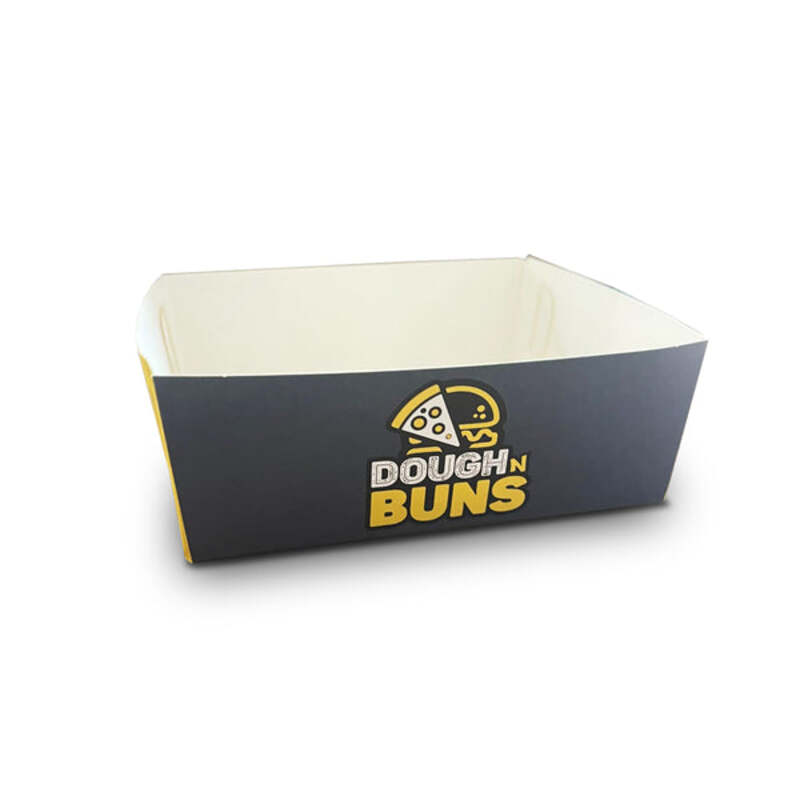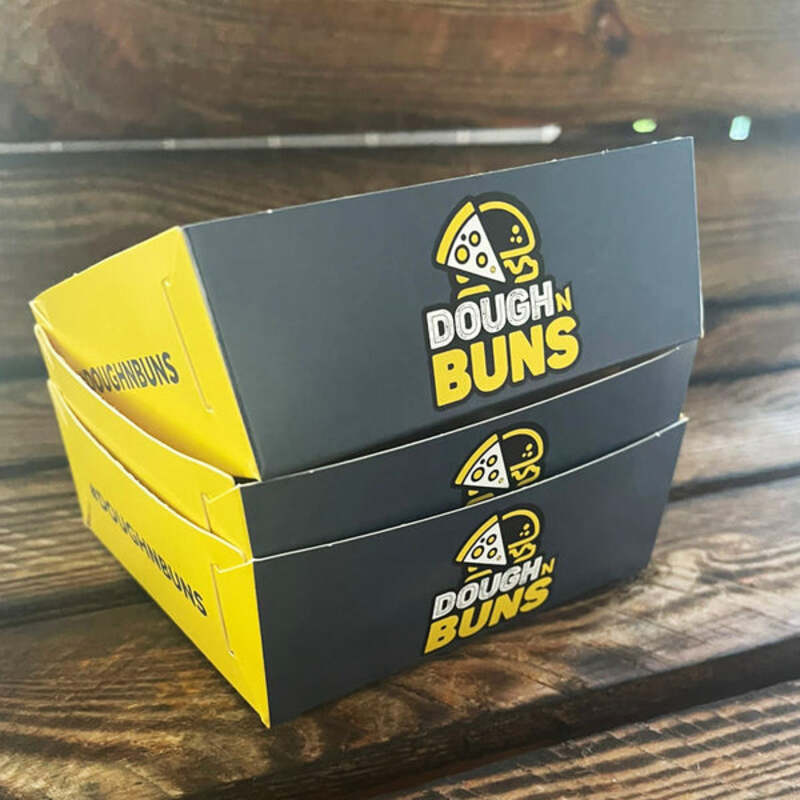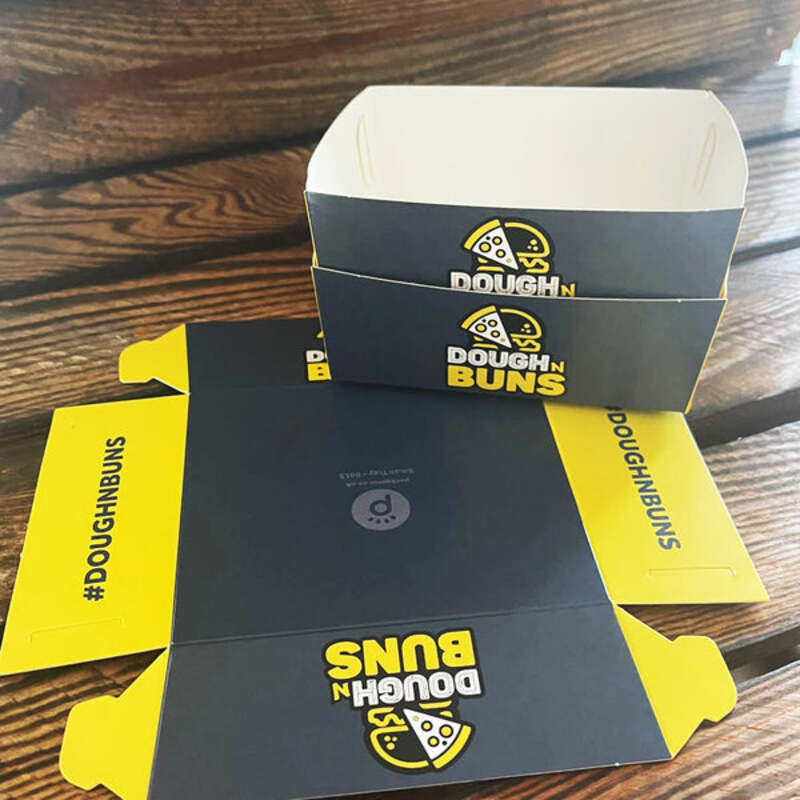The Evolving Landscape of Food Packaging
The global food service and retail sectors are experiencing unprecedented shifts, driven by escalating consumer demand for convenience, sustainability, and brand engagement. Within this dynamic environment, the role of packaging has transcended mere containment, becoming a critical element in product presentation, logistical efficiency, and consumer safety. Food packaging, especially products designed for immediate consumption or take-away, is undergoing a rapid transformation. Innovations in materials, structural design, and printing technologies are continuously redefining what is possible, moving towards solutions that are not only functional but also environmentally responsible and economically viable. This evolution emphasizes the need for specialized packaging solutions that address specific industry challenges while offering superior performance.
In this context, the Printed Food Tray - Flat Pack - Small represents a significant advancement in disposable food service packaging. It addresses core industry demands for efficient storage, ease of assembly, and effective branding. Designed for high-volume operations where space is at a premium and speed of service is paramount, these trays offer a versatile solution for a wide array of food items, from snacks and desserts to smaller portions of meals. Their flat-pack design drastically reduces shipping volumes and storage footprints, providing substantial operational savings for businesses of all sizes. Furthermore, the ability to incorporate custom printing transforms a simple container111 into a powerful marketing tool, enhancing brand visibility and customer recall.
Technical Specifications and Parameters
Understanding the technical specifications of a Printed Food Tray - Flat Pack - Small is crucial for procurement managers and operational teams to ensure optimal fit for their specific applications. These trays are engineered to meet stringent food safety and performance standards. Key parameters include material composition, which typically involves food-grade paperboard sourced from sustainable forests, often with an internal coating for grease or moisture resistance. The structural integrity is designed to withstand typical handling and temperatures associated with food service, ensuring content protection from preparation to consumption. Dimensional consistency is paramount for automated filling or quick manual assembly processes.

Figure 1: Typical dimensions and structural features of a small flat-pack food tray.
| Parameter | Value/Description |
|---|---|
| Material Composition | Food-grade Virgin Kraft or SBS Paperboard (180-350 GSM), often PE-coated or bioplastic-lined |
| Internal Dimensions (Approx.) | Top L: 100-150mm, Top W: 70-100mm, Base L: 80-120mm, Base W: 50-80mm, Height: 30-50mm |
| Printing Technology | Flexographic or Offset Printing (up to 6 colors), Food-safe inks |
| Grease/Moisture Resistance | Excellent (PE-lined or specific barrier coatings) |
| Recyclability | Depends on coating (e.g., recyclable without PE, compostable with PLA lining) |
| Certifications | FDA compliant, FSC certified, ISO 22000 (manufacturing process) |
| Temperature Range | Typically -10°C to +80°C (suitable for hot and cold foods, not for oven/microwave) |
These parameters underscore the tray's suitability for a range of culinary uses, ensuring food integrity and consumer safety. The chosen paperboard thickness, measured in Grams per Square Meter (GSM), directly impacts the tray's rigidity and durability. Higher GSM indicates a sturdier tray, often preferred for heavier or more liquid-containing items. The flat-pack nature ensures efficient logistics and storage, crucial for businesses with limited back-of-house space.
Manufacturing Process: From Pulp to Product
The production of a Printed Food Tray - Flat Pack - Small involves a sophisticated multi-stage manufacturing process, ensuring precision, hygiene, and efficiency. This process begins with the careful selection of raw materials, primarily food-grade paperboard sourced from certified sustainable forests (FSC-certified). The paperboard undergoes rigorous quality checks for consistency in thickness, strength, and surface smoothness, which are critical for optimal printing and forming.
1. Material Preparation: High-quality paperboard rolls are prepared. For applications requiring moisture or grease barriers, a thin layer of polyethylene (PE) or a bio-based alternative like Polylactic Acid (PLA) is extruded onto one side of the paperboard. This coating ensures the tray remains robust when in contact with food, preventing leaks and maintaining structural integrity.
2. Custom Printing: The flat sheets of coated paperboard are then fed into advanced printing presses. Flexographic printing is commonly used for its efficiency and ability to produce vibrant, consistent colors on paperboard, though offset printing may be employed for extremely high-resolution graphics. Food-safe inks, compliant with FDA regulations, are meticulously applied to achieve the client's desired branding and design. This step is critical for brand recognition and visual appeal.
3. Die-Cutting and Creasing: After printing, the sheets move to a high-precision die-cutting machine. Here, custom-designed steel rule dies cut the paperboard into the exact shape of the flat tray blank, complete with all necessary score lines (creases) and locking tabs. The accuracy of this stage is paramount for easy and consistent assembly of the Printed Food Tray - Flat Pack - Small by the end-user. ISO standards for dimensional tolerance are strictly followed here.

Figure 2: Illustrating the precise die-cutting process for flat-pack food trays.
4. Stripping and Stacking: Once cut, the excess paperboard (waste material) is stripped away, leaving only the individual tray blanks. These blanks are then precisely counted and stacked, ready for the flat-pack format. The flat-pack design is a key advantage, significantly reducing the volume required for shipping and storage compared to pre-formed trays.
5. Quality Control & Packaging: Throughout the entire process, multiple quality control checkpoints are in place. This includes visual inspections for print quality and defects, measurement checks for dimensional accuracy, and adhesion tests for coatings. Finished products are tested against relevant standards, such as those from the American National Standards Institute (ANSI) for material properties, and specific food safety standards (e.g., ISO 22000 for manufacturing environment). The trays are then securely packaged in moisture-resistant bulk cartons, ready for shipment. The typical lifespan of these trays, when stored correctly, exceeds 12-18 months, ensuring a long shelf life for stock management.
Application Scenarios and Industry Advantages
The versatility and practical advantages of the Printed Food Tray - Flat Pack - Small make it indispensable across a multitude of industries and specific application scenarios. Its design is particularly well-suited for fast-paced environments where quick service and efficient space utilization are critical.
Food Service & Catering: This is the primary domain for these trays. Restaurants, cafes, food trucks, and catering companies utilize them for serving everything from fries and chicken nuggets to pastries, mini-sandwiches, and fruit portions. Their ease of assembly directly on the line allows for rapid packaging of orders, enhancing operational flow. For large-scale events or catering operations, the flat-pack design means significantly more trays can be transported and stored in a given volume, reducing logistical overhead.
Retail & Supermarkets: Delis, bakeries, and prepared food sections in supermarkets use these trays for presenting grab-and-go items. The custom printing capability is invaluable here, allowing retailers to reinforce their brand, highlight product information, or promote special offers directly on the packaging. This enhances the retail experience and boosts impulse purchases.
Events & Concessions: At sports stadiums, concert venues, and fairs, the demand for quick and hygienic food service is immense. The Printed Food Tray - Flat Pack - Small provides a robust and convenient serving vessel that can be quickly erected by staff, ensuring patrons are served efficiently. Its disposability simplifies post-event cleanup.
Educational & Healthcare Institutions: Schools and hospitals often provide pre-packaged meals or snacks. These trays offer a hygienic and portion-controlled solution for distributing food items, minimizing direct handling and cross-contamination risks. The ability to print essential information or dietary warnings adds an extra layer of safety and compliance.
Key Advantages in Application:
- Space Efficiency: Flat-pack design reduces storage volume by up to 90% compared to pre-formed trays, optimizing valuable kitchen or storage space.
- Cost-Effectiveness: Lower shipping costs due to reduced volume, and competitive unit pricing make them economically attractive for high-volume users.
- Branding Opportunity: High-quality custom printing transforms packaging into a powerful marketing tool, enhancing brand visibility and perceived value.
- Hygiene & Safety: Made from food-grade materials with appropriate coatings, ensuring safe contact with food and preventing leaks.
- Environmental Consideration: Many options are available from sustainably sourced, recyclable, or compostable materials, aligning with modern corporate social responsibility initiatives.
- Ease of Use: Simple, intuitive assembly mechanism allows for quick setup even during peak operational hours.
Customization Solutions and Design Flexibility
One of the most compelling aspects of the Printed Food Tray - Flat Pack - Small is its extensive customization potential. This flexibility allows businesses to create packaging that perfectly aligns with their brand identity, operational requirements, and specific product offerings. Customization goes beyond just printing and extends to structural design and material choices, offering a tailored solution for virtually any application within the food service industry.
Brand Integration and Graphics: Custom printing is the most visible form of customization. Companies can select from a wide palette of colors, integrate complex logos, incorporate marketing messages, and even print QR codes for customer engagement. High-resolution graphics ensure that the brand image is consistently represented, turning each tray into a mobile advertisement. This is particularly valuable for establishing a unique market presence in competitive sectors.
Material Selection: While standard options include PE-coated paperboard, clients can specify alternative barrier coatings such as bioplastics (PLA) for enhanced compostability or wax coatings for specific grease resistance needs. The GSM of the paperboard can also be adjusted to increase rigidity for heavier items or to meet specific sustainability targets.
Structural Modifications: Although the small flat-pack tray has standard dimensions, manufacturers can often accommodate minor structural adjustments. This could include modifying the height of the tray walls, adjusting the angle of the sides for better nestability when assembled, or adding specific perforations or tabs for unique serving requirements. These subtle changes can significantly impact the user experience and operational efficiency.

Figure 3: Demonstrating customized branding on a printed food tray.
Eco-Friendly Options: For businesses prioritizing environmental stewardship, customization includes selecting fully recyclable, compostable, or biodegradable paperboards and coatings. Manufacturers can provide certifications like FSC for responsible forestry and independent lab tests confirming compostability or recyclability to ensure compliance with green initiatives. This level of detail in customization allows brands to communicate their sustainability commitments directly through their packaging.
The design phase for a customized Printed Food Tray - Flat Pack - Small often involves close collaboration between the client and the manufacturer’s design and engineering teams. Utilizing CAD software and rapid prototyping, precise mock-ups can be created, allowing clients to visualize and test their customized trays before mass production. This iterative process ensures that the final product meets all aesthetic, functional, and regulatory requirements.
Manufacturer Comparison: Choosing the Right Partner
Selecting the right manufacturer for Printed Food Tray - Flat Pack - Small is a critical decision that impacts not only product quality but also supply chain reliability and cost-efficiency. While many suppliers offer similar products, key differentiators lie in their manufacturing capabilities, quality assurance protocols, customization flexibility, and commitment to sustainability.
| Feature | Manufacturer A (BulkBuy Packaging) | Manufacturer B (Generic Competitor) |
|---|---|---|
| Product Quality & Consistency | High, stringent ISO 9001 & 22000 processes, automated QC | Moderate, manual checks, occasional batch variations |
| Customization Options | Extensive (full-color print, material, structural mods), dedicated design team | Limited (basic print, few material choices), template-based |
| Certifications | FDA, FSC, ISO 22000, BRCGS Packaging (global food safety standard) | Basic food contact certs, no specific environmental ones |
| Lead Time (Custom Orders) | Typically 3-5 weeks (design to delivery) | 5-8 weeks, less consistent |
| Sustainability Initiatives | Strong (recycled content, compostable options, waste reduction programs) | Minimal, basic recyclability |
| Customer Support | Proactive, dedicated account managers, technical support | Reactive, general inquiry handling |
| Minimum Order Quantity (MOQ) | Flexible, starts from 25,000 units (for custom print) | Higher, typically 50,000 units |
This comparison highlights that while price is a factor, the long-term value delivered by a manufacturer stems from their commitment to quality, innovation, and client partnership. A manufacturer with robust certification like BRCGS Packaging ensures adherence to global standards for packaging and packaging materials used in food applications, offering peace of mind. Partnering with a supplier like BulkBuy Packaging, which prioritizes advanced manufacturing, extensive customization, and verifiable sustainability, can lead to superior product performance, enhanced brand reputation, and significant operational efficiencies.
Frequently Asked Questions (FAQ)
Q1: Are the Printed Food Tray - Flat Pack - Small trays recyclable or compostable?
A1: Many versions are, depending on the material and coating. Trays made from virgin paperboard without a PE coating are generally recyclable in paper streams. If they have a PLA (polylactic acid) bio-lining, they can be industrially compostable. Always check the specific product specifications and local recycling guidelines. We offer both recyclable and compostable options.
Q2: What is the minimum order quantity (MOQ) for custom printed trays?
A2: For custom printed Printed Food Tray - Flat Pack - Small, the MOQ typically starts from 25,000 units due to the setup costs involved in printing plate preparation and machine calibration. Smaller quantities might be available for generic, unprinted versions or through specific distributor channels.
Q3: How long does it take to receive a custom order?
A3: The lead time for custom printed Printed Food Tray - Flat Pack - Small orders typically ranges from 3 to 5 weeks from final artwork approval. This includes production, quality control, and shipping. Rush orders may be possible depending on production schedules and shipping methods, often incurring additional charges.
Q4: Are these trays suitable for hot and cold food?
A4: Yes, these trays are designed to accommodate both hot and cold food items. The food-grade coating provides excellent resistance to grease and moisture, making them suitable for fried foods, baked goods, salads, and more. They are generally not recommended for use in microwaves or conventional ovens.
Quality Assurance and Customer Support
At BulkBuy Packaging, our commitment to quality is foundational to our operations, ensuring that every Printed Food Tray - Flat Pack - Small meets the highest industry standards. We implement a rigorous Quality Management System (QMS) certified to ISO 9001, alongside adherence to ISO 22000 for food safety management in our manufacturing processes. All raw materials are sourced from reputable suppliers and undergo incoming inspection to verify compliance with FDA food contact regulations and sustainability certifications such as FSC.
Our production lines incorporate in-line automated inspection systems for print quality, dimensional accuracy, and coating integrity. Post-production, samples from each batch undergo further laboratory testing, including grease resistance tests (e.g., KIT ratings), liquid absorption tests, and structural integrity evaluations. This multi-layered approach guarantees consistent performance and safety. We stand behind the quality of our products with a comprehensive warranty against manufacturing defects, ensuring customer satisfaction. Any concerns regarding product quality are addressed promptly by our dedicated technical support team, offering resolutions and preventative measures.
We pride ourselves on responsive and knowledgeable customer support. From initial consultation and design assistance to order tracking and post-delivery follow-up, our team of experts is committed to providing seamless service. Our clients benefit from direct access to account managers who understand their specific needs and can provide tailored advice on product selection, customization, and logistics. Our goal is to forge long-term partnerships built on trust and mutual success, ensuring that our packaging solutions consistently exceed expectations and contribute positively to our clients' operational efficiency and brand perception.
References
- Food and Drug Administration (FDA). (2023). Guidance for Industry: Preparation of Premarket Submissions for Food Contact Substances.
- ISO (International Organization for Standardization). (2018). ISO 22000: Food safety management systems – Requirements for any organization in the food chain.
- Forest Stewardship Council (FSC). (2022). FSC-STD-40-004 V3-1 EN Chain of Custody Certification.
- British Retail Consortium Global Standards (BRCGS). (2022). BRCGS Global Standard for Packaging Materials Issue 6.
- American National Standards Institute (ANSI). (2023). Standards for Paper and Paperboard Packaging.



